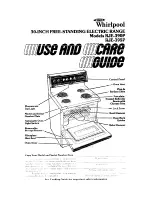
NEO 1.6 EU-En 200116-20
5
©PACIFIC ENERGY FIREPLACE
PRODUCTS LTD.
Operation
CAUTION:
Never use petrol, petrol type lantern fuel, kerosene, charcoal lighter fluid or similar liquids to start or "freshen up"
a fire in this stove. Keep all such liquids well away from the stove while it is in use.
CAUTION: Hot while in operation. Keep children, clothing and furniture away. Contact may cause skin burns.
Your PACIFIC ENERGY stove is designed for many years of trouble free operation. Over firing the appliance will shorten
the life of the product. Failure to recitify an over firing condition can be hazardous and may void the manufacturer's warranty.
Wood Selection
This stove is designed to burn natural wood only. Higher efficiency and lower emissions generally result when burning air-
dried seasoned hardwoods, as compared to softwoods or to green or freshly cut hardwoods.
Wood should be properly air dried (seasoned) for six months or more. Wet or undried wood will cause the fire to smoulder
and produce large amounts of smoke and creosote. Wet wood also produces very little heat and tends to go out often.
DO NOT BURN :
-Salt water wood *
-Treated wood
-Wet or green wood
-Coal/charcoal
-Garbage*
-Solvents
-Lawn clippings/yard waste
-Unseasoned wood
-Railroad ties
-Manure or animal remains
-Materials containing rubber, including tires
-Materials containing plastic
-Waste petroleum products, paints or paint thinners, or asphalt products
-Construction or demolition debris
-Materials containing asbestos
-Paper products, cardboard, plywood, or particleboard.
* These materials contain chlorides which will rapidly destroy metal surfaces and void warranty.
Burning these materials may result in the release of toxic fumes or render the stove ineffective and cause smoke.
The prohibition against burning these materials does not prohibit the use of fire starters made from paper, cardboard, saw
dust, wax and similar substances for the purpose of starting a fire in an affected wood stove.
Do not burn anything but wood. Other fuels, eg. charcoal, can produce large amounts of carbon monoxide, a tasteless,
odourless gas that can kill. Under no circumstances should you attempt to barbecue in this stove.
How to Test Your Wood
Add a large piece of wood to the stove when it has a good large bed of coals. It is dry if it is burning on more than one side
within one minute. It is damp if it turns black and lights within three minutes. If it sizzles, hisses and blackens without igniting
in five minutes it is soaked and should not be burnt
Lighting a Fire
WARNING: Never use chemicals or any other volatile liquid to start a fire.
1. Adjust air control to “High” position(all the way to the left) and open door.
2. Place crumpled newspaper in the centre of the stove and criss-cross with several pieces of dry kindling. Add a few small
pieces of dry wood on top.
3. Ignite the paper and leave the door ajar approimately 13mm - 25mm until the wood kindling is fully engulfed in flame.
4. After the kindling is fully engulfed add a few small logs. Close door.
5. Begin normal operation after a good coal base exists and wood has charred.
Curing of the Paint Finish
When burning your stove for the first 2-3 times it is very important that the room be well ventilated. Open all windows and
doors. Smoke and fumes caused by the curing process may cause discomfort to some individuals.






































